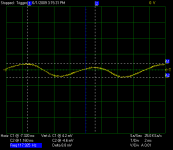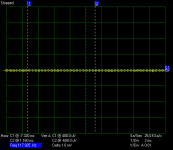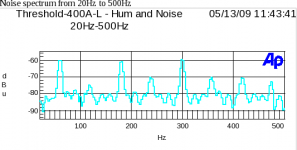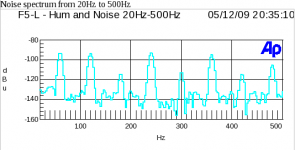I was wondering if I could get an opinion on this upgrade for a 400a? I know this is a DIY site and you are supposed to do it yourself but I do not have a lot of extra time(actually non 🙂) and I do not want to hack the amp.
It sounds good but I am looking for a little more now and if I can get good result form upgrading this amp then I will keep it. Everything works on it as I just had the led's repaired. It sure gets loud as those continues level led's start to move up to the top. 🙂
Do up grades to this amp make a noticeable difference or to get better sound is it just better to purchase a different amp? I was looking at some Krells but I do not really need all that power.
http://www.kenealeyaudio.com/Threshold400A.asp
Thanks in advance
John
It sounds good but I am looking for a little more now and if I can get good result form upgrading this amp then I will keep it. Everything works on it as I just had the led's repaired. It sure gets loud as those continues level led's start to move up to the top. 🙂
Do up grades to this amp make a noticeable difference or to get better sound is it just better to purchase a different amp? I was looking at some Krells but I do not really need all that power.
http://www.kenealeyaudio.com/Threshold400A.asp
Thanks in advance
John
Hi johndi
I have two threshold power amps although not the same model as yours.
I think you will find that all the improvements will make some difference as they are in effect modernisations.
However my exprience is that the one change that will make the most difference is changing out the power supply electrolytic capacitors. There are four large ones in your amplifier . If you note the voltage and uf value of them you then need to replace them with modern versions of the same voltage and uf value. If you do feel able to do this task then ask a repair man to make the change.
Following that my second change would be to replace the electrolytic capacitors on the two circuit boards. This is a bit more difficult as it will meaning removing the circuit boards whilst the change is made.
Threshold are very good amplifiers and well worth keeping and spending some money on to repair/modernise.
Don
I have two threshold power amps although not the same model as yours.
I think you will find that all the improvements will make some difference as they are in effect modernisations.
However my exprience is that the one change that will make the most difference is changing out the power supply electrolytic capacitors. There are four large ones in your amplifier . If you note the voltage and uf value of them you then need to replace them with modern versions of the same voltage and uf value. If you do feel able to do this task then ask a repair man to make the change.
Following that my second change would be to replace the electrolytic capacitors on the two circuit boards. This is a bit more difficult as it will meaning removing the circuit boards whilst the change is made.
Threshold are very good amplifiers and well worth keeping and spending some money on to repair/modernise.
Don
I had the pleasure of "repairing" a 30 year and 1 month old Threshold
400A over the weekend.
It had blown a fuse. Someone had put in fuses of the wrong value.
I replaced the fuses and checked it out:
-1 db at 100 KHz
.01% thd at 110 watts @ 1 KHz, 8 ohms
The caps were in good shape - the supply ripple was the stock 200 mV rms
and the output noise was about 250 uV.
Listening to it was a pleasant experience as it had been a long time. It still
sounds less "solid state" than the standard commercial product, with a nice
warm midrange and good overall tonal balance.
😎
400A over the weekend.
It had blown a fuse. Someone had put in fuses of the wrong value.
I replaced the fuses and checked it out:
-1 db at 100 KHz
.01% thd at 110 watts @ 1 KHz, 8 ohms
The caps were in good shape - the supply ripple was the stock 200 mV rms
and the output noise was about 250 uV.
Listening to it was a pleasant experience as it had been a long time. It still
sounds less "solid state" than the standard commercial product, with a nice
warm midrange and good overall tonal balance.
😎
Nelson Pass said:
checked it out ...
The caps were in good shape - the supply ripple was the stock 200 mV rms ...
What is the most reliable way when I'd like to measure "small ripple" behind the voltage regulator only with DMM and oscilloscope?
Thanks . . .
🙂
Babowana said:
What is the most reliable way when I'd like to measure "small ripple" behind the voltage regulator only with DMM and oscilloscope?
Thanks . . .
🙂
Hi Babo,
Wouldn't you:
1) make sure your scope/probes can handle the voltage your measuring
2) set your scope to AC coupled
3) connect your scope's probe reference to ground
4) connect the probe to the regulated output rail
5) adjust your sweep and vertical sensitivity...
Is there a better way?
Here is a picture of one of my unregulated rails.
Robert
Attachments
Pulling this back to this thread, (and sparing you the kinky details) let me first
say that I *LOVE* my 400A. Maybe this is obvious by the fact that I still own
it. My 400A does have a few updates done (new caps, output transistors,
and FRED), but this was more to keep it in TOP condition than to change the
sound.
WRT my 400A, I wonder about 2 things. First, one of the biggest surprises I
have learned by building some projects is how much heat affects the transistors
(and other parts) of the amp. Hence, would fixing the bias to a set level make
a noticable difference in sound quality? Generally, I would say yes, the plan
is to get the system to a set temperature and hold it there. But I notice that once
my 400A's temp is at steady state, I have not noticed the heat sinks changing
temperature with increased output level. Maybe I have not kept the output
high enough for long enough? As I did not notice a change, I don't worry
about this, other than it is yet another thing that I do not understand.
Secondly, I wonder if the 400A might benefit from a quieter power supply. I
believe the regulated supply that I made for my F5 made a very noticable and
positive difference. I wonder if the same would be true for the 400A. On the
other hand, maybe cascoding makes that less of an issue. I don't know.
I recently bought an old AP System One (finally!!!). This device is still fairly
new to me, so I may not be doing things right, but here is a graph of the hum
and noise spectrum from my 400A (input terminated into 600R).
say that I *LOVE* my 400A. Maybe this is obvious by the fact that I still own
it. My 400A does have a few updates done (new caps, output transistors,
and FRED), but this was more to keep it in TOP condition than to change the
sound.
WRT my 400A, I wonder about 2 things. First, one of the biggest surprises I
have learned by building some projects is how much heat affects the transistors
(and other parts) of the amp. Hence, would fixing the bias to a set level make
a noticable difference in sound quality? Generally, I would say yes, the plan
is to get the system to a set temperature and hold it there. But I notice that once
my 400A's temp is at steady state, I have not noticed the heat sinks changing
temperature with increased output level. Maybe I have not kept the output
high enough for long enough? As I did not notice a change, I don't worry
about this, other than it is yet another thing that I do not understand.
Secondly, I wonder if the 400A might benefit from a quieter power supply. I
believe the regulated supply that I made for my F5 made a very noticable and
positive difference. I wonder if the same would be true for the 400A. On the
other hand, maybe cascoding makes that less of an issue. I don't know.
I recently bought an old AP System One (finally!!!). This device is still fairly
new to me, so I may not be doing things right, but here is a graph of the hum
and noise spectrum from my 400A (input terminated into 600R).
Attachments
audiorob said:
Is there a better way?
Seems to be no better way. Thanks . . .
I will measure the value as you explained, and post in the other thread . . .
🙂
So I wonder if putting a quieter power supply on the 400A would reduce
THD levels at lower output levels? I suspect it would. I wonder if reducing
noise at lower output levels would make the amp reveal more detail?
BTW, I do think that the 400A has a "compressed" type of sound - or is not
quite as "dynamic" as (within its' limits) the F5. On the other hand, the 400A
sounds (and is) incredibly powerful - like there is nothing it cannot easily
handle. And this inspires me to play anything on it, as loudly as I like, without
reservation. And this is just a wonderful feeling.
Robert
THD levels at lower output levels? I suspect it would. I wonder if reducing
noise at lower output levels would make the amp reveal more detail?
BTW, I do think that the 400A has a "compressed" type of sound - or is not
quite as "dynamic" as (within its' limits) the F5. On the other hand, the 400A
sounds (and is) incredibly powerful - like there is nothing it cannot easily
handle. And this inspires me to play anything on it, as loudly as I like, without
reservation. And this is just a wonderful feeling.
Robert
- Status
- Not open for further replies.
- Home
- Amplifiers
- Pass Labs
- Would this work with a 400a?



